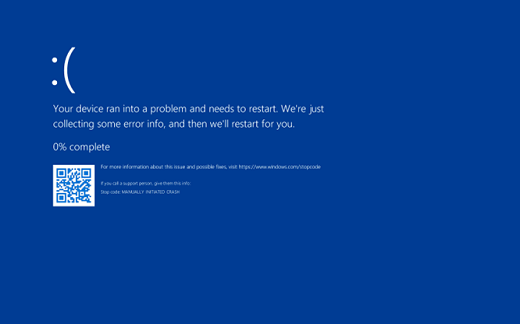It is known as the Windows Blue Screen of Death (BSoD) error is an issue that’s frequently encountered by users of computers. It’s a major problem that causes your system to fail and show an error-related blue screen. messages. The article will examine possible causes for the BSoD issue, suggest ways to correct it as well as provide tips for prevention to help prevent future incidents. While fixing this issue, if you facing a problem regarding the synthetics monitoring Here is the solution how to get synthetics monitoring to work in new relic.
Learning to understand how to deal with Windows Blue Screen of Death (BSoD)
The Blue Screen of Death, also known as BSoD is a crucial error display that occurs whenever your Windows operating system is confronted with the fatality of an error that it can’t overcome. This indicates that there is a serious system problem that demands attention in order to stop further damage from occurring. The Windows Blue Screen of Death (BSoD) Error can be identified by an eerie blue screen with black text with errors and message.
Common Reasons for Windows Blue Screen of Death (BSoD) Error
Hardware Problems
Hardware malfunctions can trigger BSoD issues. Incorrect RAM, components that are overheated or incompatible hardware could cause the error. It is vital to verify that the hardware components are in good working order and connected correctly.
Software Conflicts
Software programs that conflict or software versions that are not compatible could result in BSoD issues. If multiple applications attempt to access the same resources concurrently, this could cause system crashes or instability.
Driver Issues
Drivers that are outdated or ineffective can cause BSoD problems. Drivers are crucial software components which allow hardware devices to connect with operating systems. Drivers that are not compatible or corrupted can cause system crash.
Memory Errors or Disk Errors
Problems with the System memory (RAM) or hard disk drives could cause BSoD problems. The memory errors could be a result of malfunctioning RAM modules or error configurations. The errors on disks, like poor sectors or corrupted file systems may also trigger BSoD crash.
How Do I Troubleshoot BSoD Errors?
In order to fix BSoD issues, you must follow these troubleshooting procedures:
Make Sure You are Connected to the Hardware
Make sure that all components of the hardware have been properly connected. Verify the connections, cables and connectors and make sure they’re secure. In addition, make sure that the hardware you are using is compatible with the requirements of your system.
Update Drivers
Make sure your drivers are up to the latest version. Go to the manufacturer’s website for each component of your hardware to download the latest drivers that are compatible with the operating system you are using. The latest drivers usually include bug fixes as well as performance enhancements.
Scan your computer for Malware
Conduct a thorough analysis of your system with dependable antivirus software. The infection of malware may cause BSoD problems by destroying systems files and causing interference to important functions. Take care to remove any malware that is detected and make sure that real-time security is turned on.
Run System File Checker
It is the System File Checker (SFC) is an inbuilt Windows software that can scan for and fix damaged system files. Start the Command Prompt as an administrator and then run the “sfc scannow” command. The process could take some time, but it will repair any corrupted file with an archived copy.
Tips for Prevention to Avoid Windows Blue Screen of Death (BSoD) Error
Prevention is always more effective than cure. Here are some helpful tips to avoid Windows Blue Screen of Death (BSoD) Error:
Maintain Your System Up-to-Date
Make sure you regularly ensure that you are updating your operating system with the latest updates and patches for security. Microsoft issues updates to fix the most common vulnerabilities and issues. Maintaining your computer current reduces the likelihood of encountering Windows Blue Screen of Death (BSoD) Error messages.
Utilize a Reliable Antivirus Software
Choose a reputable antivirus and ensure it is kept up-to-date. Antivirus software helps identify and remove malicious software that may result in BSoD issues. Plan regular scanning and allow the protection in real-time for increased security.
Avoid Overclocking
Overclocking means an increase in the rate at which the clock is run by an item beyond its original setting. While it could increase performance but it can also raise the possibility of system instability as well as BSoD mistakes. Beware of overclocking if unfamiliar with the procedure or lack the appropriate cooling options.
Be wary of Third-Party Software
When you download third-party software be sure to use reliable sources. Certain software could contain malware or not be compatible with your computer, which can lead to BSoD problems. Check user reviews and to ensure compatibility prior to installing.
Conclusion
It is known as the Windows Blue Screen of Death (BSoD) error and can be an annoying issue that could cause disruption to your computer’s use. If you are aware of the cause by identifying the root of the issue, implementing troubleshooting techniques as well as adopting steps to prevent the issue, you can reduce the frequency of BSoD problems and keep your system in good condition.

